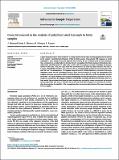Por favor, use este identificador para citar o enlazar a este item:
http://hdl.handle.net/10261/330838COMPARTIR / EXPORTAR:
 SHARE SHARE
 CORE
BASE CORE
BASE
|
|
| Visualizar otros formatos: MARC | Dublin Core | RDF | ORE | MODS | METS | DIDL | DATACITE | |

| Título: | Green fat removal in the analysis of polychlorinated biphenyls in biotic samples |
Autor: | Bintanel-Cenis, Jorge CSIC; Herrero, Laura CSIC ORCID; Gómara, Belén CSIC ORCID ; Ramos, Lourdes CSIC ORCID | Palabras clave: | Green sample preparation Deep eutectic solvents Fat removal Polychlorinated biphenyls Biotic samples Food analysis |
Fecha de publicación: | ago-2023 | Editor: | Elsevier | Citación: | Advances in Sample Preparation 7: 100081 (2023) | Resumen: | A green analytical method based on the use of a deep eutectic solvent (DES) has been proposed for fat removal in the analysis of polychlorinated biphenyl (PCBs) in biotic samples. Using priority PCB congeners as model compounds, a novel sample preparation approach fully avoiding the use of mineral acids has been developed. Once optimized, the procedure allowed fat removal to be accomplished by 30min treatment with [chlorine chlo ride]:[oxalic acid dihydrated] 1:1 molar ratio at 60°C, with 3s vortexing every 5min to facilitate the homoge nization of the slurry. Then, the target PCBs were recovered from the slurry by 20min extraction with 4mL of n-hexane. This DES-based method was combined with gas chromatography-quadrupole mass spectrometry (GC qMS) for final PCB determination. The complete analytical method provided satisfactory recoveries of the target compounds (above 87% for all analytes), using as a small amount of sample as 0.150g. The repeatability of the complete procedure, expressed as relative standard deviation, was less than 5%, and the intermediate precision better than 14%. Final validation of the proposed methodology included the satisfactory comparison of the con centrations calculated for the endogenous PCBs in selected fatty foodstuffs with lipid contents under 18% (w/w fresh weight, fw) with those found when the same samples were analyzed by a more conventional and accepted reference procedure. The limits of detection were in all cases lower than 30 pg/g fw (as calculated for real sam ples), demonstrating the feasibility of the proposed procedure for accurate determination of the target compounds in biotic samples. | Versión del editor: | https://doi.org/10.1016/j.sampre.2023.100081 | URI: | http://hdl.handle.net/10261/330838 | DOI: | 10.1016/j.sampre.2023.100081 | ISSN: | 2772-5820 |
| Aparece en las colecciones: | (IQOG) Artículos |
Ficheros en este ítem:
| Fichero | Descripción | Tamaño | Formato | |
|---|---|---|---|---|
| 1-s2.0-S2772582023000311-main.pdf | Artículo principal | 797,49 kB | Adobe PDF |  Visualizar/Abrir |
CORE Recommender
SCOPUSTM
Citations
1
checked on 23-abr-2024
WEB OF SCIENCETM
Citations
1
checked on 24-feb-2024
Page view(s)
31
checked on 01-may-2024
Download(s)
16
checked on 01-may-2024
Google ScholarTM
Check
Altmetric
Altmetric
Este item está licenciado bajo una Licencia Creative Commons

